Twice in our lives we have moved our belongings into self storage, both times of which were when we went full-time into trucking and became “homeless“:
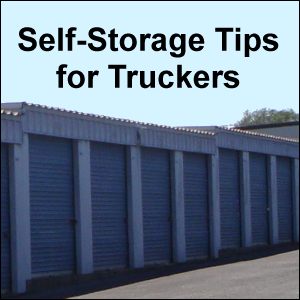 the first time in 1993 when we drove team and
the first time in 1993 when we drove team and- again in late 2009 when Vicki joined Mike in the truck that he drove for his last regional trucking company (before he started driving locally).
If you’re a professional driver who has spent time accumulating household items and you do not want to sell or give them away when you move full-time into your truck, you will need to arrange to store the belongings you won’t take with you on the road.
The mini storage industry has changed over the years.
On this page, we’re sharing our experience and other tips so that you will be prepared to save as much money as possible in the process.
Initial and Ongoing Assessments
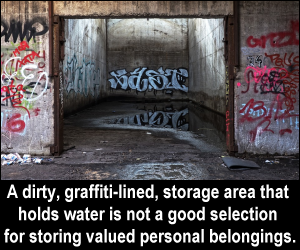 Since you’re a professional in charge of securely transporting your loads, we’re sure you know that there are certain “red flags” that point to one location being less desirable than others.
Since you’re a professional in charge of securely transporting your loads, we’re sure you know that there are certain “red flags” that point to one location being less desirable than others.
For example, a dark, dirty, unkempt location that is prone to crime is a place where you would not want to park your truck overnight.
In the same vein, use your professional judgment to assess self storage facilities.
You do not want to store your belongings in a location that does not meet your standards.
Among the questions you might ask are:
- Are the grounds and buildings well kept?
- Are the personnel on duty during business hours, professional and courteous?
- What have renters lost at the facility by any and all means?
- Would you feel completely comfortable storing your possessions there?
You would be wise to visit a prospective self storage facility more than once before you decide to rent.
If your initial and ongoing assessments of the facility do not meet your expectations, keep looking.
The Climate at Self Storage Units
Many self storage facilities now offer what is called “climate-controlled” storage units.
They keep stored items at a temperature lower (in the summer) or higher (in the winter) than the outside temperature.
We decided that we did not want to risk having certain household items ruined by temperature fluctuations that are typical in our home state of South Carolina (especially high heat in the summer).
Anything that is heat-sensitive is a candidate for being stored in one of these.
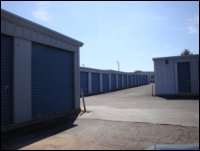
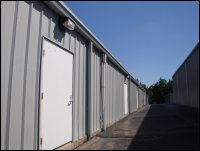 Contrast the look of the outsides of the buildings at the self storage facility where we chose to store our goods.
Contrast the look of the outsides of the buildings at the self storage facility where we chose to store our goods.
On the left are typical externally accessible non-climate controlled storage units.
On the right, you’ll see that the climate-controlled units are not accessible from the outside of the building; they have internal doors.
By virtue of the higher expense associated with controlling temperature, climate-controlled self storage units cost more to rent than non-climate controlled units.
For temperature protection and out of concern for cost, we rented the smallest climate-controlled unit that our self storage facility of choice had — and put everything else in a larger non-climate controlled unit.
Among the items we put in the climate-controlled self storage unit were:
- various non-refrigerated and non-frozen foodstuffs (such as the foods that Vicki had canned to save money;
- media (such as DVDs, CDs, videotapes and cassette tapes);
- electronic equipment (computers and peripherals); and
- some appliances.
Self Storage Security
Since you’re a professional driver who is concerned about the security of your loads, we’re sure that you will also be concerned about the security of your own household possessions once put into storage.
In visiting many self storage facilities in our area, we noticed quite a variation in the security of the premises.
Vicki noted these different security set-ups:
- Facilities where offices were located
- completely inside the gate;
- completely outside the gate; or
- with the front door outside the gate and the back door inside the gate to allow easy access for and by personnel;
- Facilities with or without a golf cart dedicated to enabling personnel to travel throughout the grounds for monitoring, maintenance and guiding prospective renters;
- A facility — when during posted office hours — the front door was locked and a sign was posted stating that the manager would return in 15 minutes from inspecting the grounds, leaving the office unmanned for doing business.
- A facility requiring the entering of a pass code to get through the gate to the storage units;
- Facilities with limited hours of access versus one where renters could access their units 24 hours per day;
- Facilities which were computer-controlled and equipped with surveillance cameras versus facilities with neither; and
- Facilities that were easily accessible by large straight moving trucks, pick-up trucks with trailers, or a large truck tractor with 26′ trailer versus those that were more difficult to navigate.
When you visit facilities in your area, be aware of security issues like these.
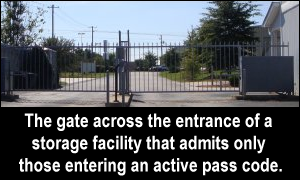 The self storage facility where we rented two units — a climate-controlled unit and a non-climate controlled unit — had a security gate.
The self storage facility where we rented two units — a climate-controlled unit and a non-climate controlled unit — had a security gate.
Only those with an active pass code could get in or out.
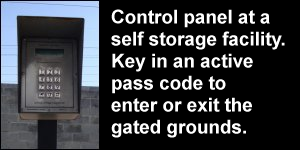 An active pass code needed to be keyed into a control panel to get in or out of the gated grounds.
An active pass code needed to be keyed into a control panel to get in or out of the gated grounds.
Locking Away Your Treasures
Every self storage unit has a latch by which the contents can be locked. There are many different types of locks on the market today.
Mike chose to use on our self storage units the same kind of lock that he has used on the back of his trailers, a Brinks shielded padlock (similar to the Master Lock shielded padlock shown here).
(For your convenience, we are linking to or listing products on Amazon.com, with which we have an affiliate relationship.)
Liability and Insurance
 Upon reading the rental agreement at our mini storage facility of choice, we understood that paragraph number four was most critical.
Upon reading the rental agreement at our mini storage facility of choice, we understood that paragraph number four was most critical.
In it, the facility clearly states that they are not liable for anything that happens to renters’ possessions once stored on their premises.
Many types of disasters can befall a commercial storage facility, just as they can a residence: hurricane, tornado, flood, leaks, earthquake, fire, theft, etc.
The burden for protecting your possessions when you sign a contract where the property owner assumes no liability is squarely the renter’s.
Before you rent any storage unit, ask about crime at the facility and do some research on crime in the area.
Your local Sheriff’s office is a good place to get this information.
At one rental facility we visited, the manager claimed that there had been only one instance of a break-in during the many years they had been in business. That case was supposedly someone who had cut off a lock on one unit (thinking it was his) but came to find out that he had remembered his unit number incorrectly. Nothing had supposedly been stolen from the unit although the lock was destroyed.
How can you protect your stored possessions?
You may purchase mini storage insurance.
However, if you are considering buying it, look to see what they do and don’t protect, and what kinds of damage may or may not be covered.
For example, if you live in a tornado-prone area, will your storage insurance policy pay out if the unit you’ve rented is destroyed by a tornado?
If you live in a coastal area, will your storage insurance policy cover damage due to a flood or storm surge?
If one policy doesn’t cover it, perhaps another, or an additional one, will.
Regarding self storage insurance, be sure to read the fine print.
There may be items that the policy will not cover, such as currency, furs, heirlooms or the like.
Remember, if the self storage unit you rent comes with absolutely no insurance to protect possessions against loss of any kind — and if your storage insurance does not cover the items most important to you — you will be bearing the entire risk of storing these items.
Self Storage Unit Dimensions
When a commercial storage facility is looking to rent a unit, management will usually only quote the dimensions as width by height (such as 10 feet wide by 15 feet long).
Don’t forget to take into account the height of the unit, too.
For those looking to maximize their self storage space, think in terms of cubic feet, not square feet.
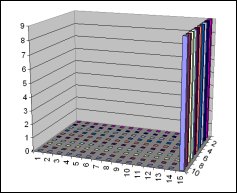 You would be wise to take a retractable metal tape measure with you to measure actual dimensions of the unit under consideration.
You would be wise to take a retractable metal tape measure with you to measure actual dimensions of the unit under consideration.
One unit we were looking to rent had a sloped ceiling that at most was about 8 feet high and sloped down to about 7 feet.
The units that we ended up renting were 9 feet high all around.
This image shows the cubic feet in a storage unit, the dimensions for which are 10 feet wide by 15 feet long by 9 feet high.
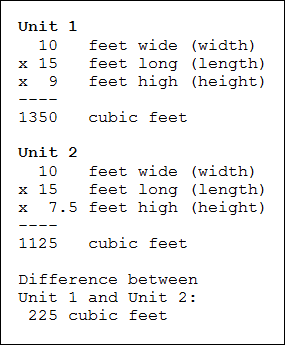
The total storage space for this unit should theoretically be 1350 cubic feet.
If a unit with the same width and length was on average only 7.5 feet high, it would have 1125 cubic feet.
Can you afford the difference in storage space?
Now no one is saying that you have to stack up your personal belongings 9 feet high, but wouldn’t it be nice to have that kind of clearance, especially if you’re tall and you have tall things?
Also, beware of construction designs within self storage units that cut down on available space.
If the side walls are “corrugated,” the ridges may reduce usable space.
Always plan storing things in a space just a little under the measurements you are given.
Packing Boxes
Obviously, to make full and efficient use of your storage space, you will want to pack similarly shaped boxes together.
For our own long term storage needs, we determined that using heavy plastic totes was preferable to using cardboard boxes.
We invested in a number of Rubbermaid Roughneck Totes, the 18-gallon size, in which to store books, office supplies, files and other paperwork.
They came in so handy that we bought more in which to store other items, particularly from the kitchen.
One of the advantages of using these totes is that they are a uniform size.
Paperboard or cardboard boxes, unless they are purchased, can come in every shape and size imaginable.
They can be efficient for packing, but inefficient for storing.
The other reason why we invested in plastic totes was to minimize potential damage from humidity.
Storing Garments
Rather than store the garments that we had had hanging in the closet in boxes or totes, we chose to hang them on a garment hanger like the one shown.
This device, which we bought in tandem with a garment rack cover, was fairly easy to assemble, but it required two people to put it together.
Having easy access to hanging garments was particularly useful when the seasons changed.
We easily retrieved or stored our winter outerwear.
If you store a garment rack near an exterior door, remember that garments may get dirty just hanging there.
“One Month Free” or Move-in Specials
We were able to get 1 month of free storage with a small commitment of time.
One resource we found said that offering the “free month” up front (or for some nominal fee like $1) at self storage facilities can lure in people who just want access to the property for evil intentions.
Be aware of this.
Discounts, Percentage Reductions, and Occupancy
 When the economy started taking a downturn in the United States, some people took that as a sign that they needed to take their belongings out of self storage perhaps to sell them for extra cash.
When the economy started taking a downturn in the United States, some people took that as a sign that they needed to take their belongings out of self storage perhaps to sell them for extra cash.
When the occupancy rate at a storage facility goes down, their profit goes down.
This may or may not have an effect on multi-unit discounts.
If you rent two or more storage units, ask the owner/manager if he/she would be willing to reduce the total monthly rental cost.
For example, we rented both
- a small climate-controlled unit (more expensive per square foot, but a good value compared to ruined media and electronics) and
- a larger non-climate controlled unit (less expensive per square foot but subject to changes in humidity and temperature).
We figure that a discount on multiple storage units is sort of like an insurance company giving a “multi-car discount” on an auto insurance policy.
We were able to obtain a small reduction in our monthly rental fee just by asking (and, no, it wasn’t 50% off).
Some self storage facilities routinely run discounts on their rental prices.
This can backfire on people who rent units during a non-discount period.
Another question that you need to have answered is: Will your rental fee stay uniform throughout your rental agreement?
Depending on your rental agreement, you may be able to pre-pay for use of storage space indefinitely into the future.
That would require a lot of money upfront, but can work out to your advantage if the price goes up multiple times while your goods are in storage.
Self Storage Association
Just as the Coin Laundry Association does not have a comprehensive list of all laundromats on its website (but only a listing of member laundromats), so the Self Storage Association does not list all of the mini storage facilities in business.
You may have better success in finding facilities near you in a phone book or online directory listing.
Moving
One of the biggest challenges for us prior to moving was reducing the amount of paperwork in our files.
We worked for weeks sorting it into three classifications:
- That which we could give to someone likely to use it (such as historical information and local maps to an organization interested in them),
- That which contained personally identifiable information but which we no longer needed (which we shredded and recycled), and
- That which we kept and put in storage.
We identified items that we could give to a church clothes closet and a charitable thrift store.
We loaned and donated many books to a local institution of higher learning.
Vicki had gone around the house measuring each piece of furniture and the large appliances.
From those measurements, she constructed, via a computer graphics program, a “floor plan” of where everything would fit in the self storage unit.
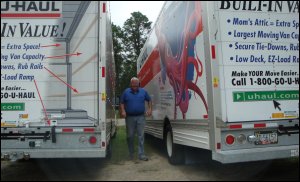 Knowing how limited the floor space was, she created “stacks” where smaller pieces would fit on top of larger ones.
Knowing how limited the floor space was, she created “stacks” where smaller pieces would fit on top of larger ones.
Having furniture that we felt was too big to move comfortably via pick-up truck, we chose the least expensive option we could find for moving those pieces into storage: friends to load a U-Haul at our residence and unload it at the storage unit.
In the photo here, Mike Simons is walking between U-Haul trucks at the moving truck rental facility where we did business.
Because of advanced planning, it took only 2 hours on moving day to
- move the large stuff out of the house,
- transported to the self storage facility and
- placed into the unit!
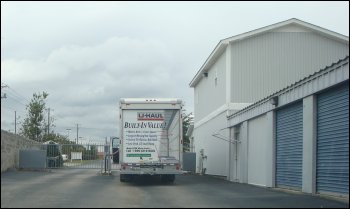 Because Vicki had purposely drawn the dimensions of the storage unit a little smaller than actual size, things actually fit much better than we anticipated!
Because Vicki had purposely drawn the dimensions of the storage unit a little smaller than actual size, things actually fit much better than we anticipated!
In this photo, Mike is leaning out of the U-Haul to punch in the security pass code to exit our self storage facility after moving our large belongings there.
Bearing these things in mind, here are some money-saving tips to help you if you decide to put your belongings into storage.
![]() Money saving tip: Plan your storage needs carefully, not renting more or less storage space than you actually need.
Money saving tip: Plan your storage needs carefully, not renting more or less storage space than you actually need.
If you are able to use storage space provided for free by someone you trust, make sure that it meets your needs better than paying for commercial storage. (Note: sometimes “free” comes with strings.)
Compare storage items (such as totes) to make sure that you don’t under-buy or over-buy.
We bought Rubbermaid Roughneck totes because they are rugged and are designed to withstand the storage conditions we have placed them in.
Also, if you can do so, buy them at the lowest cost you can find.
We bought our totes at a local Lowe’s for a whole lot less than the cost shown on Amazon. By buying local, we could actually hold the totes up to the light to see if there were any “weak spots” that might pose problems later on.
Buying moving-related items with a credit card that gives cash back bonus rewards can provide benefits later on.
If you have the time to space out the purchase of these items, they won’t hit your credit card statement all at the same time.
(Of course, we recommend paying off your credit card bill as soon as possible so as to reduce, and hopefully eliminate, interest charges.)
Engaging friends (who will hopefully help you move for free or for the cost of a meal) is less expensive than hiring a moving crew to move your belongings into storage.
Make your moving plans known as soon as possible to your friends so that they can work your event into their schedules.
The plans for renting moving trucks may include a charge per mile for the number of miles the vehicle is driven.
If you use one of these trucks, plan your trips to drive it as few miles as possible.
The use of a dolly (hand truck) or blankets or any other accessories may cost extra as well.
Don’t under-rent a dolly, especially if you’re going to be moving appliances.
The larger models are designed to help you handle more weight with less effort.
Just as you considered your storage unit’s space needs, consider your moving truck’s space limitations.
Don’t rent a smaller truck based on the per-day cost alone if you will spend more in mileage making more trips.
What savings you may have realized can easily be eaten up in per-mile charges.
We got the biggest truck U-Haul had, using all the floor space although not stacking things up as a typical mover would do.
Our goal was to load and unload it in one shot, which we did.
Return from Self Storage: A Guide for Use by Professional Truck Drivers to our Trucker Services page or our Truck Drivers Money Saving Tips home page.









